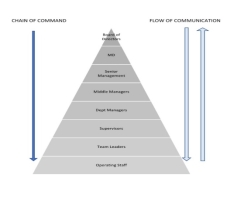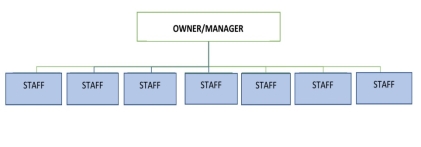Different Types of Hierarchical Organisational Structure
| ✓ Paper Type: Free Assignment | ✓ Study Level: University / Undergraduate |
| ✓ Wordcount: 1004 words | ✓ Published: 10 May 2021 |
Businesses and organisations exist for many purposes and are divided into 3 sectors:
Public Sector:
Government funded, to provide essential services to the general public.
Private Sector:
Individually financed and controlled organisations that produce goods and offer services to consumers aiming to make profit.
Third Sector:
Not for profit organisations such as charities that provide vital services to the public often overlooked by governments.
To run efficiently all organisations large or small need a structure, the structure is influenced by the aims and objectives of the organisation and the external factors that affect it. The main advantages of a recognised structure are a clear chain of command (employees know their role in the organisation and who they are responsible to) and a clear path of communication. “There are no perfect or uniform structures” (Cuthbert. M, 2020) and all organisational structures have advantages and disadvantages which businesses have to carefully consider before deciding which structure to use as restructuring an organisation is both disruptive and costly. The main objectives of an organisational structure are communication and control.

Many larger organisations use a functional structure:
A functional structure works by dividing their resources into different functions, grouping employees by speciality, each group then has a manager responsible for them. The advantages of a functional structure are that by grouping employees by skill and speciality and by keeping expertise together it can improve efficiency and productivity it can also create a ‘team spirit’ that increases motivation in turn these can minimise the costs of an operation and increase the profits. The disadvantages of a functional structure are there can be a lack of understanding across departments, less communication between departments and departments could focus on own goals rather than company objectives.
The common functions of organisations include:
Human Resources (HR)
HR deals with the recruitment and retention of employees, Health & Safety, dismissal and redundancy and the training and development of staff. HR also liaises with trade unions.
Sales & Marketing
The marketing function conducts market research, organises advertising and product promotion, the sales function deals with sales and pricing strategies for products and services.
Customer Service
The Customer service function monitors distribution, provides an after-sales service, gives consumer advice and handles enquiries and complaints.
Finance & Accounts
The finance and accounts function deals with cash flow, monitoring income/revenue, profits and losses, preparing accounts and raising finance through loans shares ect.
Research & Development
The research and development function deals with new product development, product improvements, product testing, efficiency gains and cost savings.
Production & Operations
The production/operations function deals with planning output, acquiring resources, monitoring costs, production method (batch, flow, job and cell) and efficiency.
Administration & IT
The administration and IT function deals with estate management (cleaning, Health & Safety and maintenance), reception, clerical (reporting, record keeping and communication) IT systems & website maintenance.
Larger organisations often have a tall organisational structure, often with a hierarchy that has many layers of management and supervision. A traditional hierarchy in an organisation places employees at various layers, each layer one above the other, at each layer an employee is responsible for the employees directly below (a narrow span of control) and reports to the layer directly above. Where there is a narrow span of control a manager may only be responsible for several employees.
A hierarchical structure has a long chain of command running from top to bottom where employees that have the most authority will be in the higher layers of the hierarchy and the employees with the least authority will be in the lower layers of the hierarchy. The advantages of a clear chain of command are that every employee knows their responsibilities, who they are responsible to and who they are responsible for, it can identify where and when there are problems and rectify them and vice versa identify parts of the organisation where there have been improvements, the disadvantages of a rigid chain of command could keep problems and complaints from the lower layers from the senior layers especially if they have been middle management failures as they could be blocked.
Tall, hierarchical organisational structures often have a vertical communication network where the flow of information follows the chain of command in the organisation chart. Downward communication is usually formal and can include job instructions, the explanation of company rules, policies and procedures, due to the many layers of bureaucracy that communication needs to travel through the flow of communication is often slow this can cause slow decision making, delays and confusion that hinder change and flexibility. Upward communication flows from subordinates to superiors often discussing work related problems and suggestions for improvements. Communication can also flow horizontally for example between co-workers in the same department or between sales and marketing managers sharing information or coordinating tasks. Informal information does not flow in any particular direction or through any official channels and is mostly based on friendship, shared personal or career interests.


Tall structure
– Hierarchical Structure
Smaller organisations mostly use a flat organisational structure, a flat structure lacks hierarchical layers with perhaps just one layer of management in these instances the chain of command from the top to the bottom will be short and the span of control will be wide.
A wide span of control suggests the owner/manager plays an active role in all functions of the organisation, communication is delivered quickly and is more accurate and the employees often have more responsibility and control. The disadvantages of a wide span of control are that the management workload can be heavy, there is less supervision of employees and employees have less chance of progression within the organisation and could be difficult to retain.
The flow of communication in a flat organisational structure is much faster than in a tall structure where communication flows through many layers, the speed and accuracy of communication enables much quicker decision making and the ability to adapt and implement changes quickly, managers can communicate directly with all employees and can encourage the free flow of ideas.


Flat Structure
– Wide span of control
Cite This Work
To export a reference to this article please select a referencing stye below:
Related Services
View allDMCA / Removal Request
If you are the original writer of this assignment and no longer wish to have your work published on UKEssays.com then please click the following link to email our support team:
Request essay removal



